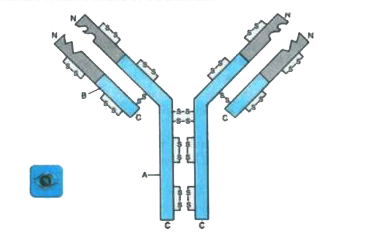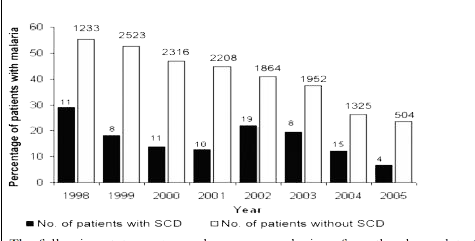Pancreas has two types of cells namely islets of Langerhans and acinar cells. In the early years of research on diabetes, extract of this gland was tested on diabetic patients. Resutls are tabulated below. (i) Extract of pancereas -
(ii) Islet cell extract +
(iii) Acinar cell extract -
The correct interpretation is that
anti-diabetic factor in extract'C' was inactivated by extract 'A'
anti-diabetic factor present in 'A' was destroyed by 'B'
both 'A' and 'C' destoyed the anti=diabetic factor present in 'B'
anti diabetic factor present in 'B' was destroyed by
The correct Answer is:D
The result shows that the extract of pancereas is ineffective to reduce blood sugar level. The extract contains secretions of both exocrine and endocrine part i.e., acinar cells and iselt of Langerhans respectively Since extract of endocrine part which is islet of Langerhans is individually capable of reducing sugar level, this shows that some factors from acinar cells are preventing anti-factor from acinar cells are preventing anti-diabetic factor to function.
Topper's Solved these Questions
Similar Questions
With the advent of DNA technology tool is available to identify a criminal or to the real parents. (a) Name this technique. (b) Write the missing steps in the procedure given below. Three of these steps are mentioned in the flow chart. (i) Extraction of DNA from the cells (ii) .......(iii) DNA is cut into fragments by restriction enzyme (iv) ..... (v)...... (vi). ....(vii) Autoradiography
View SolutionProtective proteinous chemical compounds produed by the immune cells in response to antigens are called antibodies, also called immunoglobulins. There are five classes of antibodies: IgA, IgD, IgE, IgG and IgM. Following diagram is that of a specific class of antibodies. Observe the diagram and answer the questions listed below the diagram:
(i) To which class of antibodies, this antibody belongs to ?
(ii) Identify the parts of the diagram labelled as A and B.
(iii) Give the name of the part of antibody which binds the antigen.
(iv) Which type of immune system is formed by the antibodies?

View Solution
Knowledge Check
Assertion : Type-I diabetes is caused by destruction of B cells of islets of Langerhans.
Reason : Insulin can be taken as pills.AIf both assertion and reason are true and reason is the correct explanation of assertion.BIf both assertion and reason are true but reason is not the correct explanation of assertion.CIf assertion is true but reason is false.DIf both assertion and reason are false.Redox reactions play a pivotal role in chemistry and biology. The value of standard reduction potetials (E∘) of the two half cells reactions decide which way the reaction is expected to proceed. A simple example is of Daniell cell in which zinc goes into solution and copper gets deposited. Given below are a set of half-cell reactions (acidic medium) along with with E∘ values. Using the data obtain the correct explanation to the questions that are mentioned.
I2+e−→2I−,E∘=0.54 V
Cl2+2e−→2Cl−,E∘=1.36 V
Mn2++2e−→Mn,E∘=1.50 V
Fe3++e−→Fe2+,E∘=0.77 V
O2+4H++4e−→2H2O,E∘=1.23 V.
Sodium fusion extract obtained from aniline, on treatment with iron (II) sulphate and H2SO4 in the presence of air, gives a prussian blue precipitate. The blue colour is due to the formation of :AFe4[Fe(CN)6]3BFe3[Fe[(CN)6]2CFe4[Fe(CN)6]2DFe3[Fe(CN)6]3.Given below are two statements each with one or more blanks. Select the option which correctly fills up the blanks in the statements.
Statements:
In a mixed population, those that can better-adapt, (i) and increase in population size. No variant is
(ii) wiped out.
Similarly, excess use of herbicides, pesticides, etc., has only resulted in selection of resistant varieties in a much
(iii) time scale. This is also true for microbes against which we employ antibiotics or drugs against eukaryotic organisms/cell. Hence, resistant organisms/cells are appearing in a time scale of months or years and not centuries. These are examples of evolution by (iv) action. This also tells us that evolution is not a (v) process in the sense of determinism. It is a (vi) process based on chance events in nature and chance
(vii)in the organisms.A(i) - survive, (ii) completely, (iii) lesser, (iv) anthropogenic, (v) direct, (vi) stochastic, (vii) mutationB(i) - survive, (ii) completely, (iii) lesser, (iv) anthropogenic, (v) indirect, (vi) stochastic, (vii) mutationC(i) - survive, (ii) completely, (iii) more, (iv) anthropogenic, (v) direct, (vi) stochastic, (vii) mutationD(i) - survive, (ii) incompletely, (iii) lesser, (iv) anthropogenic, (v) direct, (vi) stochastic, (vii) mutation
Rahu, is studying in clas X whereas his younger brother Mohan is a student of clas VI. Mohan has been asked by his teacher to make a working model to show that some non-metal can also be a good conductor of electricity. Mohan has already made an electric circuit by using a dry cell whose both the terminals are connected to two long copper wires having crocodile clips attached to their ends, and one of the copper wires has a torch bulb connected in it through a bulb holder. Mohan, however failked to get a non-metal which could conduct electricity. Mohan asked his brother for help. Rahul told Mohan to take a pencil, sharpen this pencil at both ends, and then connect it in the circuit made by him attaching the two crocodile clips at its two ends. Mohan did the same. As soon as the pencil sharpened at both ends was connected in the circuit the torch bulb started glowing.
(a) Of what substance is theblack core of pencil made? What does the glowing of bulb in this activity indicate?
(b) Name the element of which the above substance is anallotrope?
(c) Which allotrope of this element:
(i) is used in glass cutters?
(ii) is used in luibricating oils?
(iii) has a spherical molecule made up of 60 atoms?
(d) Name two properties of this element due to which it forms a large number of compounds.
(e) Name one compound each of this element which is used:
(i) as a solvent.
(ii) to ripen raw fruits
(iii) to preserve are displayed by Rahul in this episode?
View Solution(a) Name the secretions of the following structures :
(i) Lobules of pancreas (ii) Islets of Langerhans
(b) What is the role of insulin and glucagon hormones ? Name the cells which secrete them.
View SolutionWhich of the following statements are correct regarding the development of embryo sac ?
(i) The type of nuclear division is free , in which there is no formation of the cell wall .
(ii) Out of the eight nuclei , six are surrounded by a cell wall .
(iii) Central cell situated below the egg apparatus.
View SolutionSickle cell anemia is a genetic disorder where the body produces an abnormal hemoglobin called hemoglobin S. Red blood cells are normally flexible and round, but when the hemoglobin is defective, blood cells take on a “sickle” or crescent shape. Sickle cell anemia is caused by mutations in a gene called HBB. It is an inherited blood disorder that occurs if both the maternal and paternal copies of the HBB gene are defective. In other words, if an individual receives just one copy of the defective HBB gene, either from mother or father, then the individual has no sickle cell anemia but has what is called “sickle cell trait”. People with sickle cell trait usually do not have any symptoms or problems but they can pass the mutated gene onto their children. There are three inheritance scenarios that can lead to a child having sickle cell anemia:
- Both parents have sickle cell trait
- One parent has sickle cell anemia and the other has sickle cell trait
- Both parents have sickle cell anemia

The following statements are drawn as conclusions from the above data (Kenya).
I. Patients with SCD (Sickle Cell Disease) are less likely to be infected with malaria.
II. Patients with SCD (Sickle Cell Disease) are more likely to be infected with malaria.
III. Over the years the percentage of people infected with malaria has been decreasing.
IV. Year 2000 saw the largest percentage difference between malaria patients with and without SCD.
Choose from below the correct alternative.
View SolutionFuel cells : Fuel cells are galvanic cells in which the chemical energy of fuel cell is directly converted into electrical energy. A type of fuel cell is a hydrogen − oxygen fuel cell. It consists of two electrodes made up of two porous graphite impregnated with a catalyst ( platinum, silver, or metal oxide ). The electrodes are placed in aqueous solution of NaOH . Oxygen and hydrogen are continuously fed into the cell. Hydrogen gets oxidized to H⊕ which is neutralized by c−OH,i.e., anodic reaction.

At cathode, O2 gets reduced to c−OH
Hence, the net reaction is
The overall reaction has
ΔH=−285.6kJmol−1 and ΔG=−237.4kJmol−1 at 25∘C
A fuel cell is
I. A voltaic cell in which continuous supply of fuels are sent at anode to perform oxidation.
II. A voltaci cell in which fuels such as :CH4,H2, and CO are used up at anode.
III. One which involves the reaction of H2−O2 fuel cell such as :
Anode :2H2O+4c−OH→4H2O(l)+4ec−
Cathode :O2+2H2O(l)=4e−→4c−OH
IV. The efficiency of H2−O20 fuel cell is 70 to 75%
View Solution

